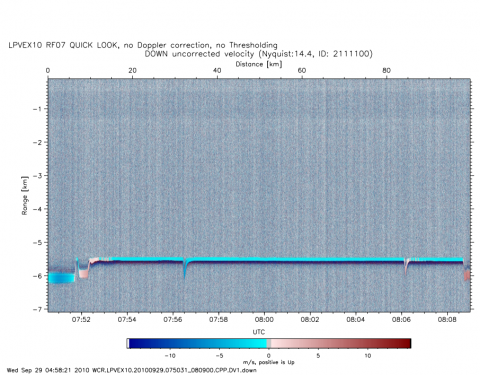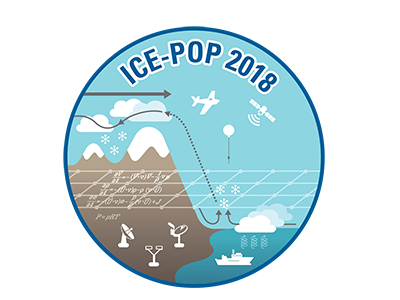 The NASA Global Hydrology Resource Center (GHRC) Distributed Active Archive Center (DAAC) published the GPM Ground Validation Kumpula Mast Meteorological Data LPVEx dataset. This dataset comprised of temperature, radiation, and wind measurements collected by the Station for Measuring Ecosystem-Atmosphere Relations III (SMEAR III) Kumpula Mast in Helsinki, Finland. This occurred during the Global Precipitation Measurement (GPM) mission Light Precipitation Validation Experiment (LPVEx) field campaign. This field campaign took place around the Gulf of Finland, aiming to provide additional high-latitude, light rainfall measurements for the improvement of GPM satellite precipitation algorithms. These meteorological dataset files are available from September 17 through October 21, 2010 in ASCII text format. It should be noted that these dataset files are not available for each day of the campaign period. Missing dates include: 09/23/10 - 10/10/10, 10/13/10, and 10/15/10 - 10/18/10.
The NASA Global Hydrology Resource Center (GHRC) Distributed Active Archive Center (DAAC) published the GPM Ground Validation Kumpula Mast Meteorological Data LPVEx dataset. This dataset comprised of temperature, radiation, and wind measurements collected by the Station for Measuring Ecosystem-Atmosphere Relations III (SMEAR III) Kumpula Mast in Helsinki, Finland. This occurred during the Global Precipitation Measurement (GPM) mission Light Precipitation Validation Experiment (LPVEx) field campaign. This field campaign took place around the Gulf of Finland, aiming to provide additional high-latitude, light rainfall measurements for the improvement of GPM satellite precipitation algorithms. These meteorological dataset files are available from September 17 through October 21, 2010 in ASCII text format. It should be noted that these dataset files are not available for each day of the campaign period. Missing dates include: 09/23/10 - 10/10/10, 10/13/10, and 10/15/10 - 10/18/10.GHRC News
 The NASA Global Hydrology Resource Center (GHRC) Distributed Active Archive Center (DAAC) published the GPM Ground Validation Kumpula Mast Meteorological Data LPVEx dataset. This dataset comprised of temperature, radiation, and wind measurements collected by the Station for Measuring Ecosystem-Atmosphere Relations III (SMEAR III) Kumpula Mast in Helsinki, Finland. This occurred during the Global Precipitation Measurement (GPM) mission Light Precipitation Validation Experiment (LPVEx) field campaign. This field campaign took place around the Gulf of Finland, aiming to provide additional high-latitude, light rainfall measurements for the improvement of GPM satellite precipitation algorithms. These meteorological dataset files are available from September 17 through October 21, 2010 in ASCII text format. It should be noted that these dataset files are not available for each day of the campaign period. Missing dates include: 09/23/10 - 10/10/10, 10/13/10, and 10/15/10 - 10/18/10.
The NASA Global Hydrology Resource Center (GHRC) Distributed Active Archive Center (DAAC) published the GPM Ground Validation Kumpula Mast Meteorological Data LPVEx dataset. This dataset comprised of temperature, radiation, and wind measurements collected by the Station for Measuring Ecosystem-Atmosphere Relations III (SMEAR III) Kumpula Mast in Helsinki, Finland. This occurred during the Global Precipitation Measurement (GPM) mission Light Precipitation Validation Experiment (LPVEx) field campaign. This field campaign took place around the Gulf of Finland, aiming to provide additional high-latitude, light rainfall measurements for the improvement of GPM satellite precipitation algorithms. These meteorological dataset files are available from September 17 through October 21, 2010 in ASCII text format. It should be noted that these dataset files are not available for each day of the campaign period. Missing dates include: 09/23/10 - 10/10/10, 10/13/10, and 10/15/10 - 10/18/10.
The NASA Global Hydrology Resource Center (GHRC) DAAC was selected to host many of the datasets associated with the GOES-R Post Launch Test field campaign. The campaign took place from March to May 2017. This was a joint NASA / NOAA effort with several NASA resources being used to support the calibration and validation of the Advanced Baseline Imager (ABI) and Geostationary Lightning Mapper (GLM). This included the NASA ER-2 aircraft that carried a number of instruments, such as the Cloud Radar System (CRS) shown here. The CRS is a nadir pointing radar that provides high-resolution profiles of reflectivity and Doppler velocity observations. It is capable of detecting cirrus clouds, precipitation, and other features from the aircraft’s location to the surface. This video is a demonstration of GHRC working to visualize the CRS data as part of the larger Field Campaign Explorer project. The video follows the ER-2 from 1256 UTC to 1903 UTC on May 14, 2017 as the aircraft flew over storms in the Atlantic Ocean east of Florida. As the ER-2 moves, the CRS nadir pointing observations are added. Furthermore, at the bottom of the video are the CRS data “unrolled” from start to stop (and moving in time from left to right) in a cross sectional view that is perpendicular to the flight track. As the video progresses, a highlight bar covering 37 minutes of time shows the observations in relation to the ER-2 animation. The upper left shows the full ER-2 flight track for this day.
 The NASA Global Hydrology Resource Center (GHRC) Distributed Active Archive Center (DAAC) published the GPM Ground Validation Wyoming Cloud Radar (WCR) LPVEx V2 dataset. This dataset includes reflectivity and Doppler velocity measurements obtained by the Wyoming Cloud Radar (WCR) flown on board the University of Wyoming King Air (UWKA) aircraft, as well as aircraft navigation parameters. These data were collected as part of the Light Precipitation Validation Experiment (LPVEx) in September and October of 2010 around the Gulf of Finland. The dataset was collected to aid in achieving the overarching goals of LPVEx, to conduct a comprehensive evaluation of precipitation algorithms for current and future satellite platforms and to detect and understand the process of light rainfall formation at high latitudes. Data files are available in netCDF-3 format from September 16 through October 20, 2010 along with browse imagery in PDF and PNG format. It should be noted that the UWKA aircraft did not operate each day of the campaign, therefore, data are only available on flight days.
The NASA Global Hydrology Resource Center (GHRC) Distributed Active Archive Center (DAAC) published the GPM Ground Validation Wyoming Cloud Radar (WCR) LPVEx V2 dataset. This dataset includes reflectivity and Doppler velocity measurements obtained by the Wyoming Cloud Radar (WCR) flown on board the University of Wyoming King Air (UWKA) aircraft, as well as aircraft navigation parameters. These data were collected as part of the Light Precipitation Validation Experiment (LPVEx) in September and October of 2010 around the Gulf of Finland. The dataset was collected to aid in achieving the overarching goals of LPVEx, to conduct a comprehensive evaluation of precipitation algorithms for current and future satellite platforms and to detect and understand the process of light rainfall formation at high latitudes. Data files are available in netCDF-3 format from September 16 through October 20, 2010 along with browse imagery in PDF and PNG format. It should be noted that the UWKA aircraft did not operate each day of the campaign, therefore, data are only available on flight days.
The NASA Global Hydrology Resource Center (GHRC) DAAC updated the GPM Ground Validation McGill Vertical Pointing X-Band (VertiX) Radar GCPEx dataset by adding GIF imagery. This dataset consists of radar reflectivity and Doppler velocity data collected by the Vertically Pointing X-band (VertiX) radar during the Global Precipitation Measurement (GPM) mission Cold-season Precipitation Experiment (GCPEx) field campaign in Ontario, Canada during the 2011-2012 winter season. VertiX can detect all precipitation targets and some ice clouds, as well as measure the Doppler velocity of precipitation targets. These measurements contributed to the overarching goal of GCPEx to collect various snowfall data for the improvement of GPM satellite winter precipitation estimates. These data files are available from January 15 through February 29, 2012 in netCDF-3 format with browse imagery available in GIF format. It should be noted that for dates that have 2 netCDF-3 files, there is a gap in the data recording time between the end of the "*.nc" file and the beginning of the "*_1.nc" file.
 The NASA Global Hydrology Resource Center (GHRC) DAAC published the GPM Ground Validation Autonomous Parsivel Unit (APU) ICE POP dataset. This dataset was collected during the International Collaborative Experiments for Pyeongchang 2018 Olympic and Paralympic Winter Games (ICE POP) field campaign in South Korea. The two major objectives of ICE POP were to study severe winter weather events in regions of complex terrain and improve the short-term forecasting of such events. These data contributed to Global Precipitation Measurements mission Ground Validation (GPM GV) campaign efforts to improve satellite estimates of orographic winter precipitation. This dataset consists of precipitation data including precipitation amount, precipitation rate, reflectivity in Rayleigh regime, liquid water content, drop diameter, and drop concentration. Data are available in ASCII format from October 31, 2015 through July 1, 2018. It should be noted that this dataset extends prior to the field campaign.
The NASA Global Hydrology Resource Center (GHRC) DAAC published the GPM Ground Validation Autonomous Parsivel Unit (APU) ICE POP dataset. This dataset was collected during the International Collaborative Experiments for Pyeongchang 2018 Olympic and Paralympic Winter Games (ICE POP) field campaign in South Korea. The two major objectives of ICE POP were to study severe winter weather events in regions of complex terrain and improve the short-term forecasting of such events. These data contributed to Global Precipitation Measurements mission Ground Validation (GPM GV) campaign efforts to improve satellite estimates of orographic winter precipitation. This dataset consists of precipitation data including precipitation amount, precipitation rate, reflectivity in Rayleigh regime, liquid water content, drop diameter, and drop concentration. Data are available in ASCII format from October 31, 2015 through July 1, 2018. It should be noted that this dataset extends prior to the field campaign.






